Mapping and Geomorphic Characterization of the Vast Cold-Water Coral Mounds of the Blake Plateau
Abstract
:1. Introduction
- Determine the known extent of CWC mound features;
- Generate an objective standardized geomorphic characterization of the region;
- Examine the relationship between mound landforms and seafloor substrates;
- Test the application of the Coastal and Marine Ecological Classification Standard (CMECS) to substrates and geomorphic features in the study area [43].
2. Materials and Methods
2.1. Study Area
2.2. Bathymetric Synthesis and Estimation of the Largest CWC Province on the Blake Plateau
2.3. Objective Geomorphic Analysis of the Study Area
2.4. Geomorphic Analysis of Subregions and Mound Relief
- Two were selected as examples of large mounds formed along the top of steep geologic scarp features of the terrain (“Jellyfish Mounds” and “Richardson Mounds”).
- Four subregions were selected based on their unique spatial pattern of mound features not observed elsewhere in the region (“Streamlined Mounds”, “Ripple Mounds”, “Mini Mounds”, and “Sparse Mounds”).
- One region was selected as a large newly mapped CWC mound area outside the existing coral Habitat Area of Particular Concern protection boundary (“Pinnacle Mounds”). Sparse Mounds also met this criterion.
- One was selected for its exceptionally high mound densities over a large continuous spatial extent (“Million Mounds”). This area forms the core of the largest continuous extent of coral described in the paper (white polygon in Figure 2).
2.5. Substrate Classification and Comparison with Landforms
3. Results
3.1. Extent and Geomorphic Characterization of the Cold-Water Coral Province
3.2. Geomorphic Diversity of Subregions
3.3. Substrate Classes of Landform Types
4. Discussion and Conclusions
Author Contributions
Funding
Data Availability Statement
Acknowledgments
Conflicts of Interest
References
- Roberts, J.M.; Wheeler, A.J.; Freiwald, A. Reefs of the deep: The biology and geology of cold-water coral ecosystems. Science 2006, 312, 543–547. [Google Scholar] [CrossRef]
- Mayer, L.; Jakobsson, M.; Allen, G.; Dorschel, B.; Falconer, R.; Ferrini, V.; Lamarche, G.; Snaith, H.; Weatherall, P. The Nippon Foundation—GEBCO Seabed 2030 Project: The Quest to See the World’s Oceans Completely Mapped by 2030. Geosciences 2018, 8, 63. [Google Scholar] [CrossRef]
- de Carvalho Ferreira, M.L.; Robinson, L.F.; Stewart, J.A.; Li, T.; Chen, T.; Burke, A.; White, N.J. Spatial and temporal distribution of cold-water corals in the Northeast Atlantic Ocean over the last 150 thousand years. Deep. Sea Res. Part I Oceanogr. Res. Pap. 2022, 190, 103892. [Google Scholar] [CrossRef]
- Lunden, J.J.; McNicholl, C.G.; Sears, C.R.; Morrison, C.L.; Cordes, E.E. Acute survivorship of the deep-sea coral Lophelia pertusa from the Gulf of Mexico under acidification, warming, and deoxygenation. Front. Mar. Sci. 2014, 1, 78. [Google Scholar] [CrossRef]
- Georgian, S.E.; Shedd, W.; Cordes, E.E. High-resolution ecological niche modelling of the coldwater coral Lophelia pertusa in the Gulf of Mexico. Mar. Ecol. Prog. Ser. 2014, 506, 145–161. [Google Scholar] [CrossRef]
- Quattrini, A.M.; Nizinski, M.S.; Chaytor, J.D.; Demopoulos, A.W.; Roark, E.B.; France, S.C.; Moore, J.A.; Heyl, T.; Auster, P.J.; Kinlan, B. Exploration of the Canyon-Incised Continental Margin of the Northeastern United States Reveals Dynamic Habitats and Diverse Communities. PLoS ONE 2015, 10, e0139904. [Google Scholar] [CrossRef]
- Wheeler, A.J.; Beyer, A.; Freiwald, A.; De Haas, H.; Huvenne, V.A.; Kozachenko, M.; Olu-Le Roy, K.; Opderbecke, J. Morphology and environment of cold-water coral carbonate mounds on the NW European margin. Int. J. Earth Sci. 2007, 96, 37–56. [Google Scholar] [CrossRef]
- Genin, A.; Dayton, P.K.; Lonsdale, P.F.; Spiess, F.N. Corals on seamount peaks provide evidence of current acceleration over deep-sea topography. Nature 1986, 322, 59–61. [Google Scholar] [CrossRef]
- Messing, C.; Neumann, A.; Lang, J. Biozonation of Deep-Water Lithoherms and Associated Hardgrounds in the Northeastern Straits of Florida. Palaios 1990, 5, 15–33. [Google Scholar] [CrossRef]
- Reed, J.K. Comparison of deep-water coral reefs and lithoherms off southeastern USA. Hydrobiologia 2002, 471, 57–69. [Google Scholar] [CrossRef]
- Stetson, T.R.; Squires, D.F.; Pratt, R.M. Coral banks occurring in deep water on the Blake Plateau. Am. Mus. Nat. Hist. 1962, 2114, 1–39. [Google Scholar]
- Neumann, A.C.; Ball, M.M. Submersible observations in the Straits of Florida: Geology and bottom currents. Geol. Soc. Am. Bull. 1970, 81, 2861–2874. [Google Scholar] [CrossRef]
- Freiwald, A.; Fosså, J.H.; Grehan, A.; Koslow, T.; Roberts, J.M. Cold-Water Coral Reefs; UNEP-WCMC: Cambridge, UK, 2004. [Google Scholar]
- Cordes, E.E.; Mienis, F.; Gasbarro, R.; Davies, A.; Baco, A.R.; Bernardino, A.F.; Clark, M.; Freiwald, A.; Hennige, S.; Huvenne, V.A.I.; et al. A Global View of the Cold-Water Coral Reefs of the World. In The Cold-Water Coral Reefs of the World; Cordes, E.E., Mienis, F., Eds.; Springer: Berlin/Heidelberg, Germany, 2024; pp. 1–30. [Google Scholar]
- Reed, J.K.; Weaver, D.C.; Pomponi, S.A. Habitat and fauna of deep-water Lophelia pertusa coral reefs off the southeastern U.S.: Blake plateau, Straits of Florida, and Gulf of Mexico. Bull. Mar. Sci. 2006, 78, 343–375. [Google Scholar]
- Roberts, J.M.; Wheeler, A.; Freiwald, A.; Cairns, S. Cold-Water Corals: The Biology and Geology of Deep-Sea Coral Habitats; Cambridge University Press: Cambridge, UK, 2009; p. 367. [Google Scholar]
- Cordes, E.E.; McGinley, M.P.; Podowski, E.L.; Becker, E.L.; Lessard-Pilon, S.; Viada, S.T.; Fisher, C.R. Coral communities of the deep Gulf of Mexico. Deep.-Sea Res. Part I-Oceanogr. Res. Pap. 2008, 55, 777–787. [Google Scholar] [CrossRef]
- Henry, L.A.; Roberts, J.M. Global Biodiversity in Cold-Water Coral Reef Ecosystems. In Marine Animal Forests; Rossi, S., Bramanti, L., Gori, A., Orejas Saco del Valle, C., Eds.; Springer: Cham, Switzerland, 2016. [Google Scholar] [CrossRef]
- Mortensen, P.B.; Hovlund, M.; Brattegard, T.; Farestveit, R. Deep water bioherms of the scleractinian coral Lophelia pertusa (L.) at 64o N on the Norwegian shelf: Structure and associated megafauna. Sarsia 1995, 80, 145–158. [Google Scholar] [CrossRef]
- Jones, C.G.; Lawton, J.H.; Shachak, M. Organisms as ecosystem engineers. Oikos 1994, 69, 373–386. [Google Scholar] [CrossRef]
- Soetaert, K.; Mohn, C.; Rengstorf, A.; Grehan, A.; van Oevelen, D. Ecosystem engineering creates a direct nutritional link between 600-m deep cold-water coral mounds and surface productivity. Sci. Rep. 2016, 6, 35057. [Google Scholar] [CrossRef] [PubMed]
- Fosså, J.; Mortensen, P.; Furevik, D. The deep-water coral Lophelia pertusa in Norwegian waters: Distribution and fishery impacts. Hydrobiologia 2002, 471, 1–12. [Google Scholar] [CrossRef]
- Cordes, E.E.; Jones, D.O.B.; Schlacher, T.A.; Amon, D.J.; Bernardino, A.F.; Brooke, S.; Carney, R.; DeLeo, D.M.; Dunlop, K.M.; Escobar-Briones, E.G. Environmental Impacts of the Deep-Water Oil and Gas Industry: A Review to Guide Management Strategies. Front. Environ. Sci. 2016, 4, 58. [Google Scholar] [CrossRef]
- Parker, S.; Penney, A.; Clark, M. Detection criteria for managing trawl impacts on vulnerable marine ecosystems in high seas fisheries of the South Pacific Ocean. Mar. Ecol. Prog. Ser. 2009, 397, 309–317. [Google Scholar] [CrossRef]
- Grasmueck, M.; Eberli, G.P.; Viggiano, D.A.; Correa, T.; Rathwell, G.; Luo, J. Autonomous underwater vehicle (AUV) mapping reveals coral mound distribution, morphology, and oceanography in deep water of the Straits of Florida. Geophys. Res. Lett. 2006, 33, L23616. [Google Scholar] [CrossRef]
- Kilgour, J.M.; Auster, P.J.; Packer, D.; Purcell, M.; Packard, G.; Dessner, M.; Sherrell, A.; Rissolo, D. Use of AUVs to Inform Management of Deep-Sea Corals. Mar. Technol. Soc. J. 2014, 48, 21–27. [Google Scholar] [CrossRef]
- Angeletti, L.; Castellan, G.; Montagna, P.; Remia, A.; Taviani, M. The Corsica Channel cold-water coral province. Front. Mar. Sci. 2020, 7, 661. [Google Scholar] [CrossRef]
- Hebbeln, D.; Wienberg, C.; Wintersteller, P.; Freiwald, A.; Becker, M.; Beuck, L.; Dullo, C.; Eberli, G.P.; Glogowski, S.; Matos, L. Environmental forcing of the Campeche cold-water coral province, southern Gulf of Mexico. Biogeosciences 2014, 11, 1799–1815. [Google Scholar] [CrossRef]
- Taviani, M.; Angeletti, L.; Canese, S.; Cannas, R.I.; Cardone, F.; Cau, A.N.; Cau, A.B.; Follesa, M.C.; Marchese, F.; Montagna, P. The Sardinian cold-water coral province in the context of the Mediterranean coral ecosystems. Deep Sea Res. Part II Top. Stud. Oceanogr. 2017, 145, 61–78. [Google Scholar] [CrossRef]
- Wienberg, C.; Titschack, J.; Freiwald, A.; Frank, N.; Lundälv, T.; Taviani, M.; Beuck, L.; Schröder-Ritzrau, A.; Krengel, T.; Hebbeln, D. The giant Mauritanian cold-water coral mound province: Oxygen control on coral mound formation. Quat. Sci. Rev. 2018, 185, 135–152. [Google Scholar] [CrossRef]
- Gasbarro, R.; Sowers, D.; Margolin, A.; Cordes, E.E. Distribution and predicted climatic refugia for a reef-building cold-water coral on the southeast US margin. Glob. Change Biol. 2022, 28, 7108–7125. [Google Scholar] [CrossRef] [PubMed]
- Hain, S.; Corcoran, E. The status of the cold-water coral reefs of the world. In Status of Coral Reefs of the World; Wilkinson, C., Ed.; Australian Institute of Marine Science: Perth, Australia, 2004; pp. 115–135. [Google Scholar]
- Partyka, M.L.; Ross, S.W.; Quattrini, A.M.; Sedberry, G.R.; Birdsong, T.W.; Potter, J.; Gottfried, S. Southeastern United States Deep-Sea Corals (SEADESC) Initiative: A Collaborative Effort to Characterize Areas of Habitat-Forming Deep-Sea Corals; NOAA Technical Memorandum OAR OER 1; National Oceanic and Atmospheric Administration: Silver Spring, MD, USA, 2007.
- Reed, J.K.; Messing, C.; Walker, B.K.; Brooke, S.; Correa, T.B.; Brouwer, M.; Udouj, T.; Farrington, S. Habitat characterization, distribution, and areal extent of deep-sea coral ecosystems off Florida, Southeastern USA. Caribb. J. Sci. 2013, 47, 13–30. [Google Scholar] [CrossRef]
- Ross, S.W.; Nizinski, M.S. State of deep coral ecosystems in the U.S. Southeast Region: Cape Hatteras to Southeastern Florida. In The State of Deep Coral Ecosystems of the United States; Lumsden, S.E., Hourigan, T.F., Bruckner, A.W., Dorr, G., Eds.; NOAA Technical Memorandum CRCP 3; National Oceanic and Atmospheric Administration: Silver Spring, MD, USA, 2007; pp. 239–269. [Google Scholar]
- Zibrowius, H. Les Scléractiniaires de la Méditerranée et de l’Atlantique nord-oriental. Mémoires De L’institut Océanographique Monaco 1980, 11, 1–284. [Google Scholar]
- Larcom, E.A.; McKean, D.L.; Brooks, J.M.; Fisher, C.R. Growth rates, densities, and distribution of Lophelia pertusa on artificial structures in the Gulf of Mexico. Deep. Sea Res. Part I Oceanogr. Res. Pap. 2014, 85, 101–109. [Google Scholar] [CrossRef]
- Galvez, K.C. The Distribution and Growth Patterns of Cold-Water Corals in the Straits of Florida. Ph.D. Thesis, University of Miami, Coral Gables, FL, USA, 2020. [Google Scholar]
- Ayers, M.W.; Pilkey, O.H. Piston cores and surficial sediment investigations of the Florida-Hatteras slope and inner Blake Plateau. In Environmental Geologic Studies on the Southeastern Atlantic Outer Continental Shelf; Popenoe, P., Ed.; USGS Open File Report 81-582-A; U.S. Geological Survey: Reston, VI, USA, 1981; pp. 5-1–5-89. Available online: https://pubs.usgs.gov/of/1981/0582a/report.pdf (accessed on 2 November 2023).
- SAFMC. Deepwater Coral HAPCs. South Atlantic Fisheries Management Council. Available online: https://safmc.net/managed-areas/deep-water-coral-hapcs/ (accessed on 2 November 2023).
- Wagner, D.; Etnoyer, P.J.; Schull, J.C.; Nizinski, M.S.; Hickerson, E.L.; Battista, T.A.; Netburn, A.N.; Harter, S.L.; Schmahl, G.P.; Coleman, H.; et al. Science Plan for the Southeast Deep Coral Initiative (SEDCI), 2016–2019; NOAA Technical Memorandum NOS NCCOS 230; National Oceanic and Atmospheric Administration: Charleston, SC, USA, 2017; p. 96. Available online: https://coastalscience.noaa.gov/data_reports/science-plan-for-the-southeast-deep-coral-initiative-sedci-2016-2019/ (accessed on 2 November 2023).
- Cordes, E. #DEEPSEARCH. Temple University. Available online: https://sites.temple.edu/cordeslab/research/dep-search/ (accessed on 8 January 2024).
- FGDC-STD-018-2012; Coastal and Marine Ecological Classification Standard. FGDC (Federal Geographic Data Committee): Reston, VA, USA, 2012.
- Baringer, M.O.; Larsen, J.C. Sixteen years of Florida Current transport at 27° N. Geophys. Res. Lett. 2001, 28, 3179–3182. [Google Scholar] [CrossRef]
- Richardson, P.L. Florida Current, Gulf Stream, and Labrador Current. Encycl. Ocean. Sci. 2001, 2, 1054–1064. [Google Scholar]
- Hogg, N.G.; Johns, W.E. Western boundary currents. U.S. National Report to International Union of Geodesy and Geophysics 1991–1994. Suppl. Rev. Geophys. 1995, 33, 1311–1334. [Google Scholar] [CrossRef]
- Ross, S.W. Review of distribution, habitats, and associated fauna of deep water coral reefs on the southeastern United States Continental Slope (North Carolina to Cape Canaveral, FL). S. Atl. Fish. Manag. Counc. Rep. 2006, 1, 1–36. [Google Scholar]
- Masetti, G.; Mayer, L.A.; Ward, L.G. A bathymetry- and reflectivity-based approach for seafloor segmentation. Geosciences 2018, 8, 14. [Google Scholar] [CrossRef]
- Sowers, D.; Dijkstra, J.A.; GMasetti, G.; Mayer, L.A.; Mello, K.; Malik, M. Application of the Coastal and Marine Ecological Classification Standard to Gosnold Seamount, North Atlantic Ocean. In Seafloor Geomorphology as Benthic Habitat: Geohab Atlas of Seafloor Geomorphic Features and Benthic Habitat, 2nd ed.; Elsevier Inc.: Amsterdam, The Netherlands, 2019; p. 1076. [Google Scholar]
- Sowers, D.C.; Masetti, G.; Mayer, L.A.; Johnson, P.; Gardner, J.V.; Armstrong, A.A. Standardized Geomorphic Classification of Seafloor within the United States Atlantic Canyons and Continental Margin. Front. Mar. Sci. 2020, 7, 9. [Google Scholar] [CrossRef]
- Dolan, M.F.; Bjarnadóttir, L.R. Highlighting broad-scale morphometric diversity of the seabed using geomorphons. GEUS Bull. 2023, 52, 8337. [Google Scholar] [CrossRef]
- Jasiewicz, J.; Stepinski, T.F. Geomorphons—A pattern recognition approach to classification and mapping of landforms. Geomorphology 2013, 182, 147–156. [Google Scholar] [CrossRef]
- Hydroffice. Bathymetric- and Reflectivity-Based Estimator of Seafloor Segments (BRESS). Available online: https://www.hydroffice.org/bress/main (accessed on 2 November 2023).
- Walbridge, S.; Slocum, N.; Pobuda, M.; Wright, D.J. Unified Geomorphological Analysis Workflows with Benthic Terrain Modeler. Geosciences 2018, 8, 94. [Google Scholar] [CrossRef]
- Cordes, E.E.; Demopoulos, A.W.J.; Davies, A.J.; Gasbarro, R.; Rhoads, A.C.; Lobecker, E.; Sowers, D.; Chaytor, J.D.; Morrison, C.L.; Weinnig, A.M. Expanding our view of the cold-water coral niche and accounting of the ecosystem services of the reef habitat. Sci. Rep. 2023, 13, 19482. [Google Scholar] [CrossRef]
- Van der Kaaden, A.S.; Mohn, C.; Gerkema, T.; Maier, S.R.; de Froe, E.; van de Koppel, J.; van Oevelen, D. Feedbacks between hydrodynamics and cold-water coral mound development. Deep. Sea Res. Part I Oceanogr. Res. Pap. 2021, 178, 103641. [Google Scholar] [CrossRef]
- Grehan, A.J.; Unnithan, V.; Olu-Le Roy, K.; Opderbecke, J. Fishing impacts on Irish deepwater coral reefs: Making a case for coral conservation. In: Barnes PW, Thomas JP (eds) Benthic habitats and the effects of fishing. Am. Fish. Soc. Symp. 2005, 41, 819–832. [Google Scholar]
- Koslow, J.A.; Boehlert, G.W.; Gordon, J.D.M.; Haedrich, R.L.; Lorance, P.; Parin, N. Continental slope and deep-sea fisheries: Implications for a fragile ecosystem. ICES J. Mar. Sci. 2000, 57, 548–557. [Google Scholar] [CrossRef]
- Cyr, F.; van Haren, H.; Mienis, F.; Duineveld, G.; Gourgault, D. On the influence of cold-water coral mound size on flow hydrodynamics, and vice versa. Geophys. Res. Lett. 2016, 43, 775–783. [Google Scholar] [CrossRef]
- Ross, S.W.; Quattrini, A.M. The fish fauna associated with deep coral banks off the southeastern United States. Deep. Sea Res. Part I Oceanogr. Res. Pap. 2007, 54, 6. [Google Scholar] [CrossRef]
- Fosså, J.H.; Lindberg, B.; Christensen, O.; Lundälv, T.; Svellingen, I.; Mortensen, P.B.; Alvsvåg, J. Mapping of Lophelia reefs in Norway: Experiences and survey methods. In Cold-Water Corals and Ecosystems; Freiwald, A., Roberts, J.M., Eds.; Springer: Berlin/Heidelberg, Germany, 2005; pp. 359–391. [Google Scholar]
- ICES. Report of the ICES Advisory Committee on Ecosystems, 2002. ICES Coop. Res. Rep. 2002, 254, 129. [Google Scholar]
- World Wildlife Fund. The Røst Reef—A Potential MPA. Available online: https://wwf.panda.org/our_work/our_focus/oceans_practice/coasts/coral_reefs/ (accessed on 10 October 2020).
- Steinmann, L.; Baques, M.; Wenau, S.; Schwenk, T.; Spiess, V.; Piola, A.R.; Bozzano, G.; Violante, R.; Kasten, S. Discovery of a giant cold-water coral mound province along the northern Argentine margin and its link to the regional Contourite Depositional System and oceanographic setting. Mar. Geol. 2020, 427, 106223. [Google Scholar] [CrossRef]

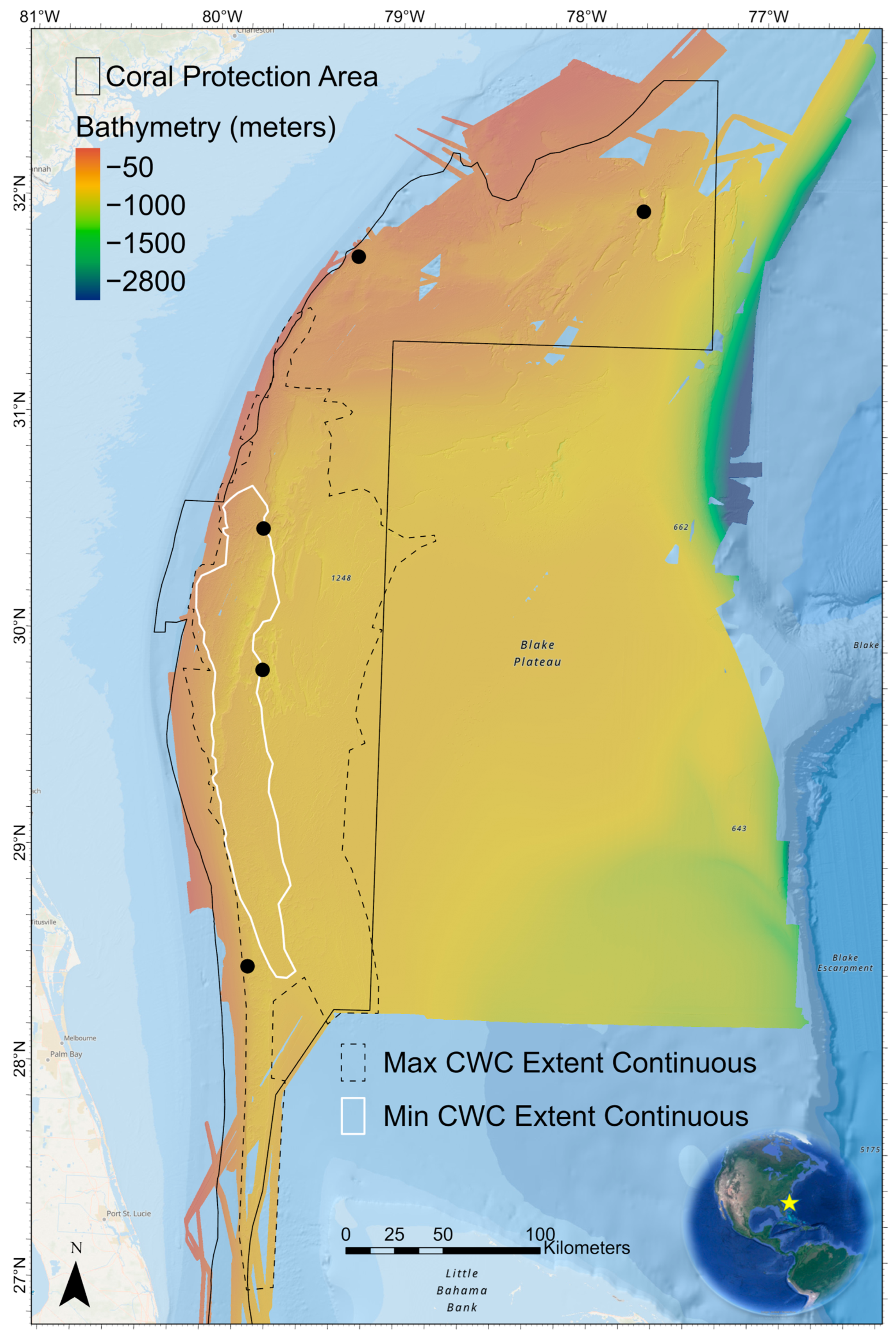



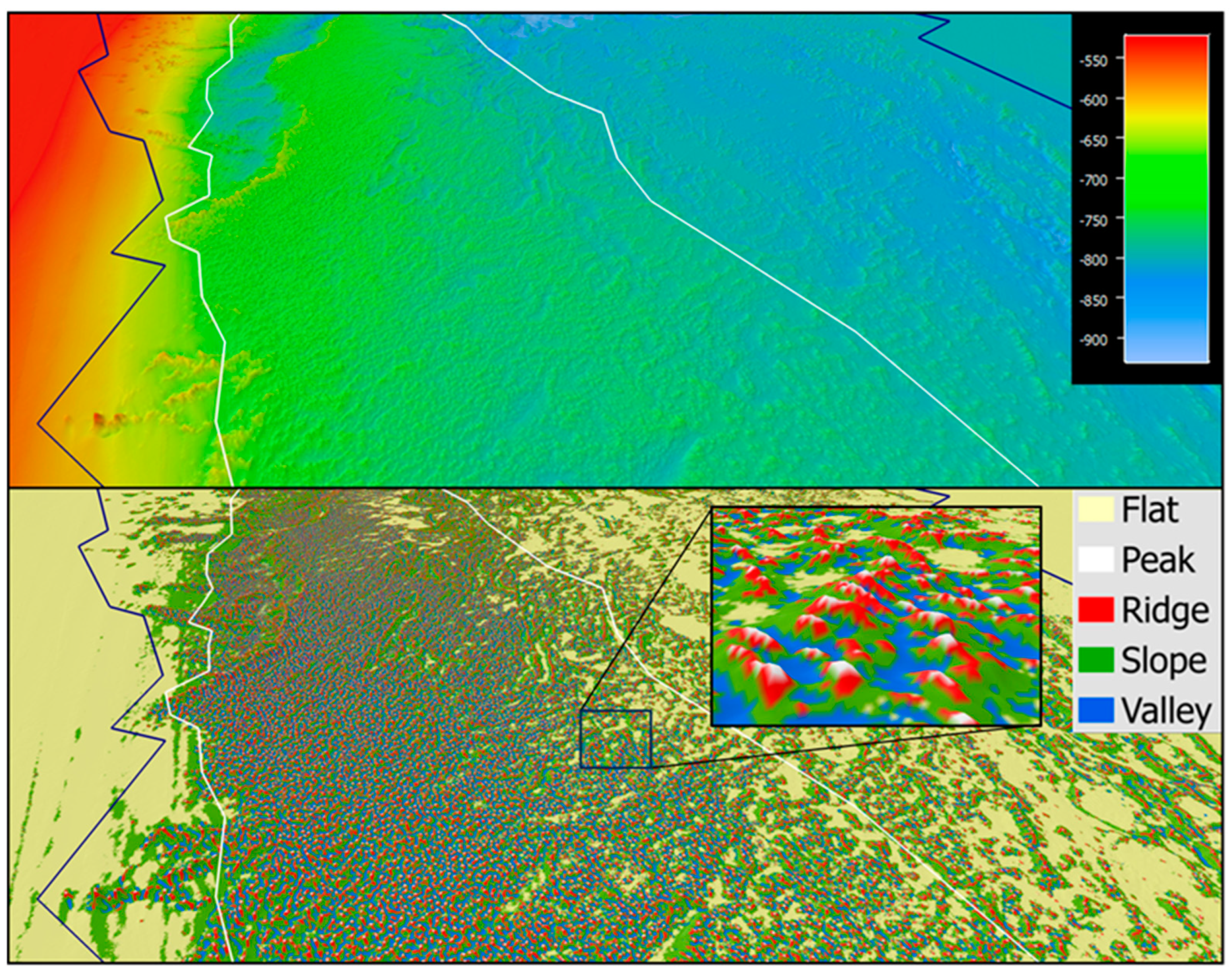
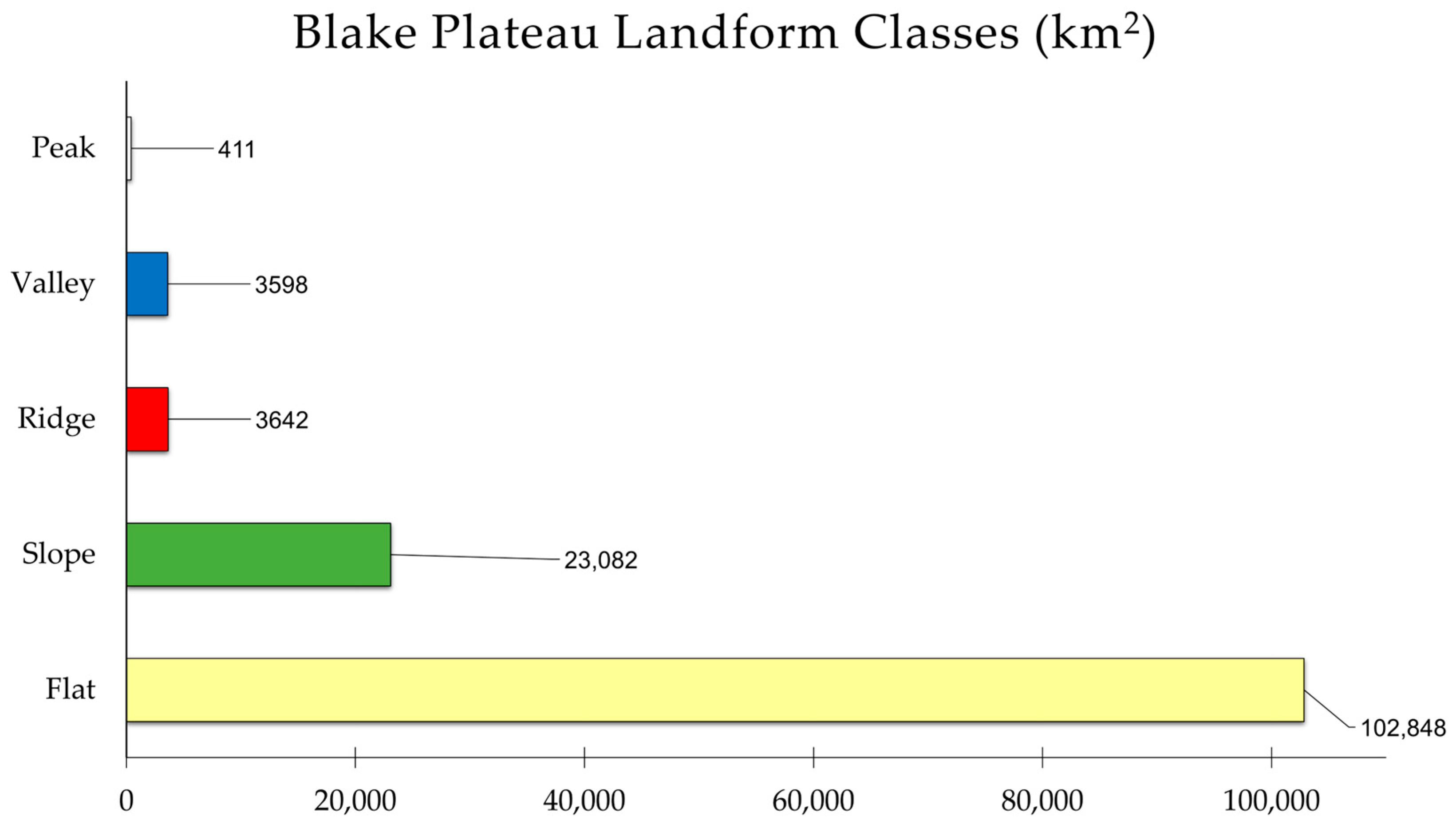



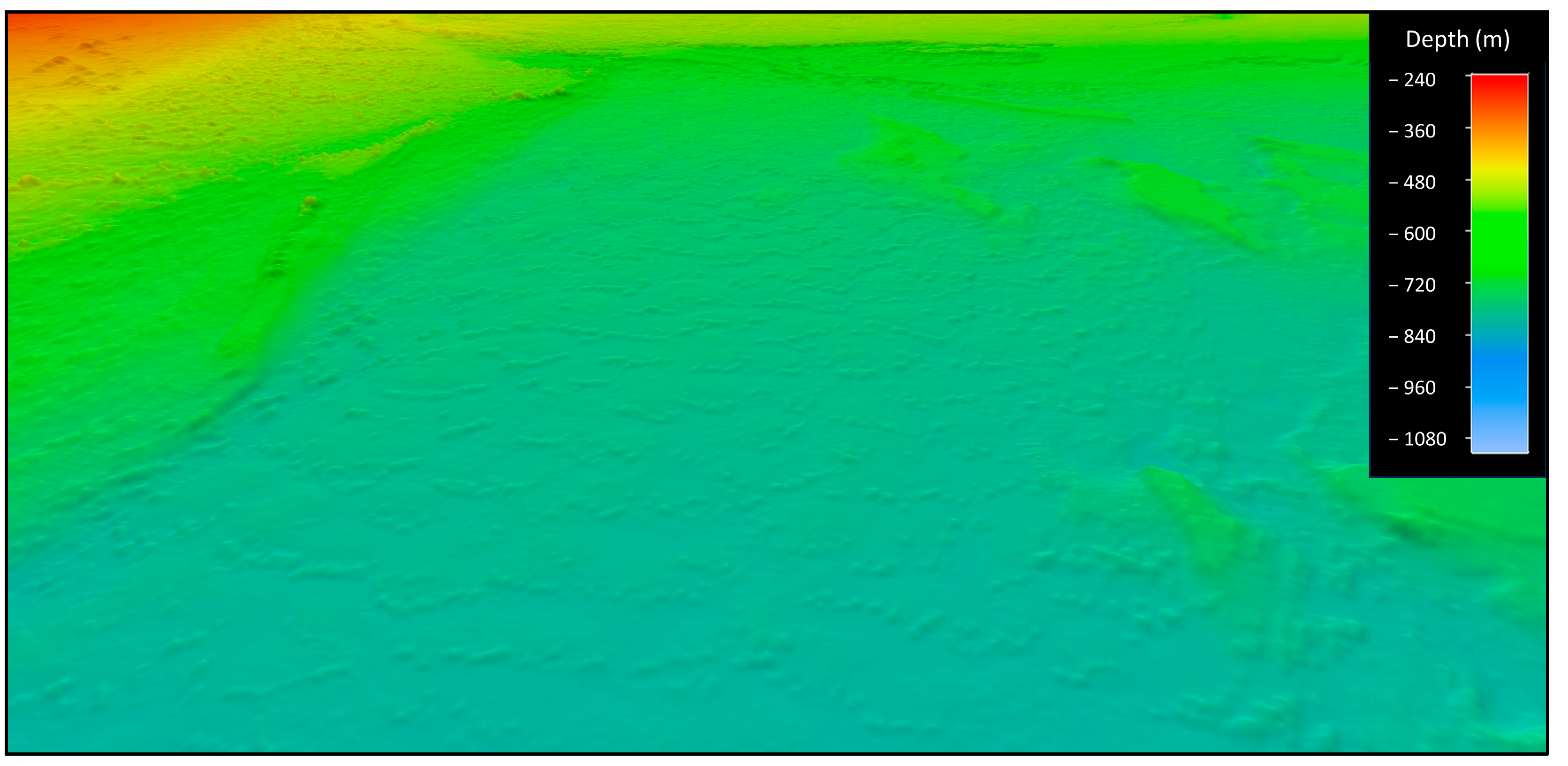

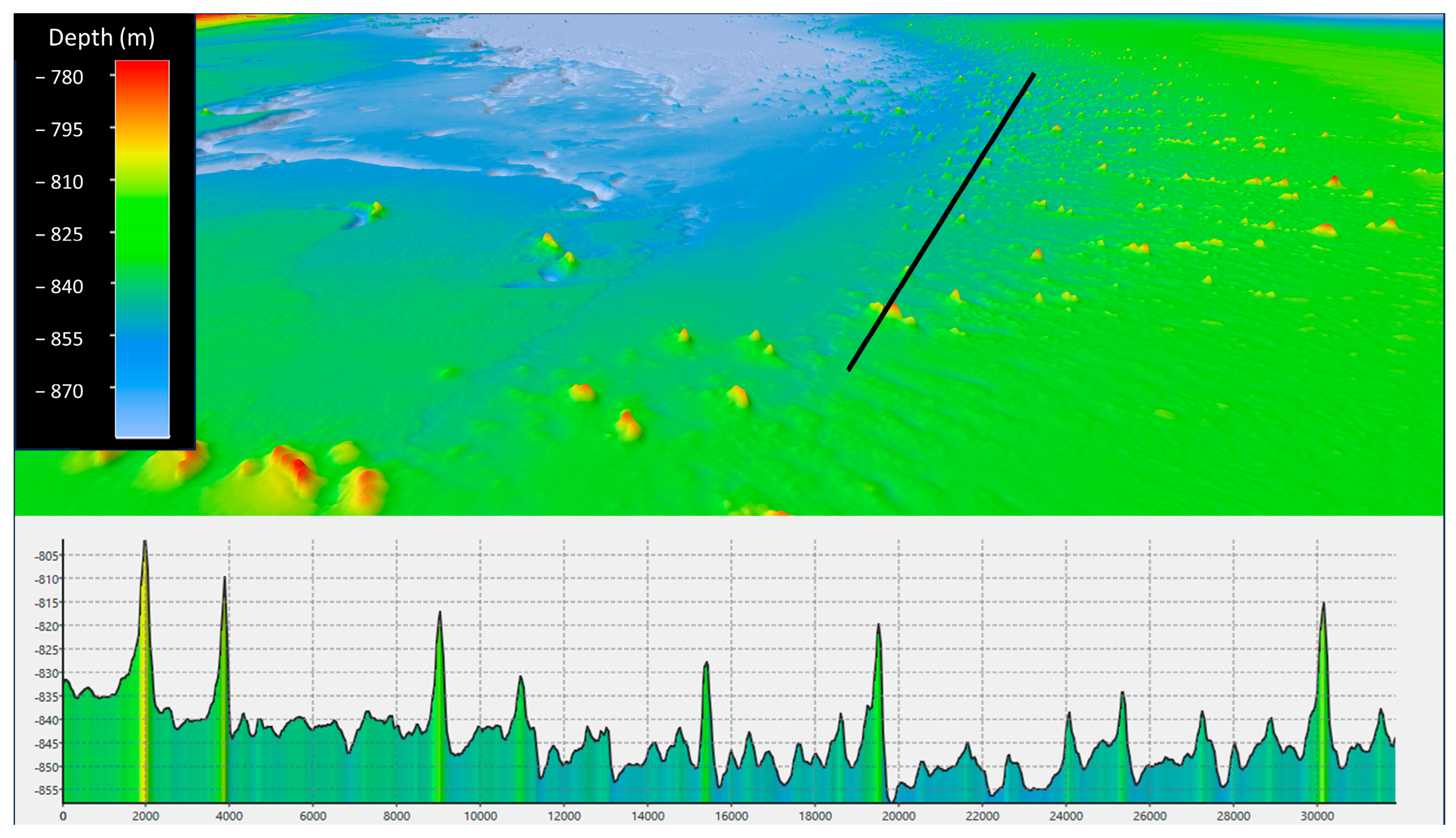
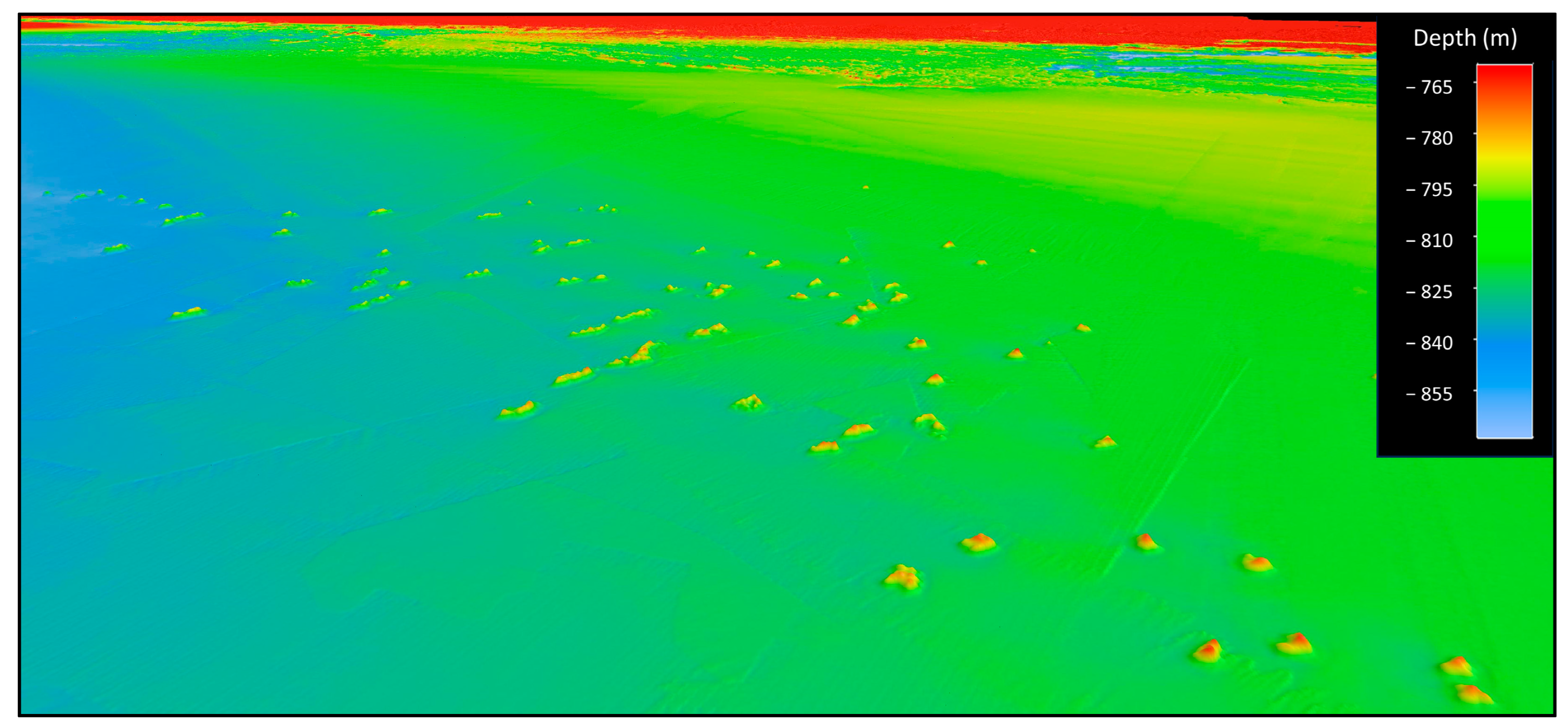

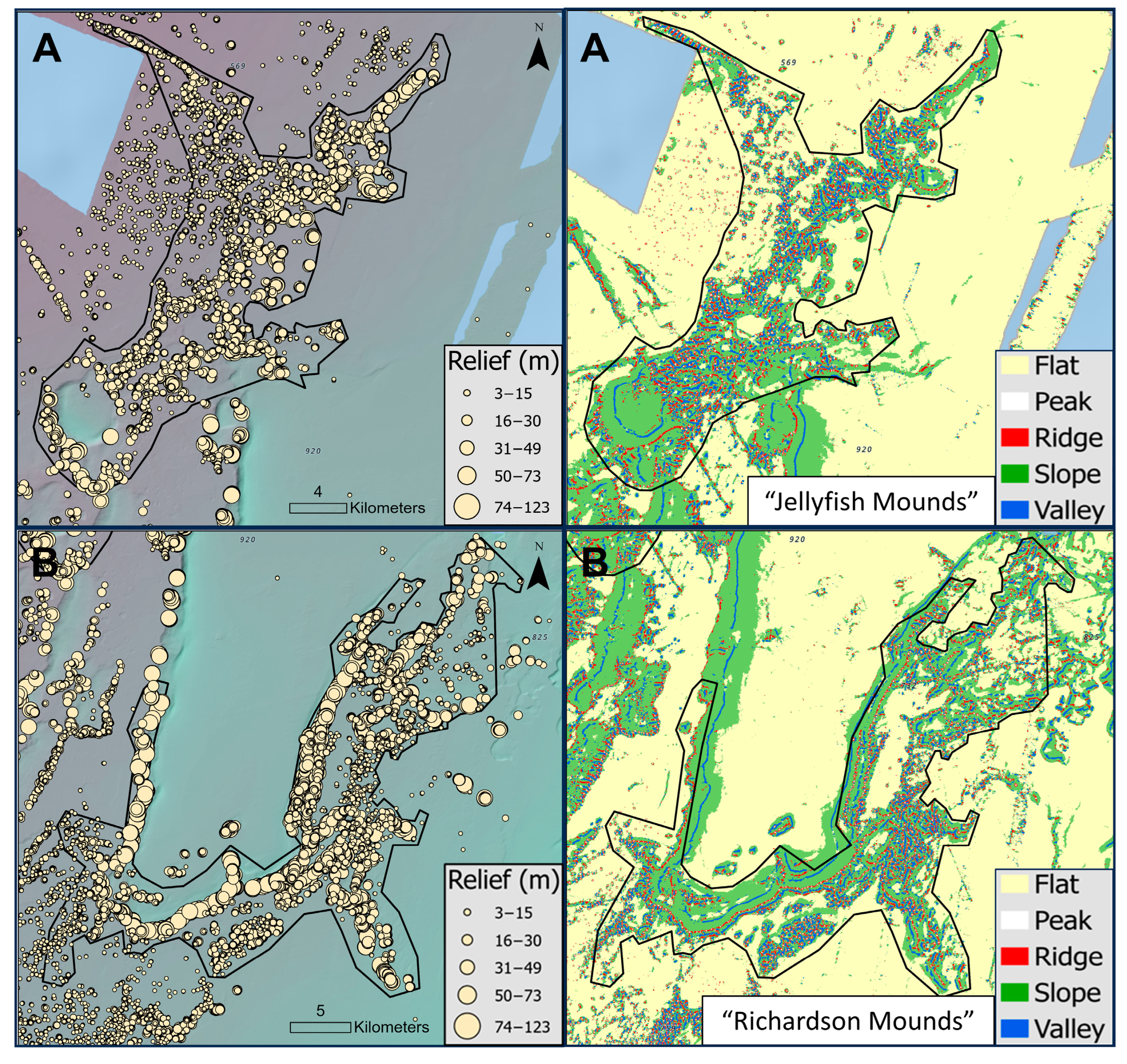
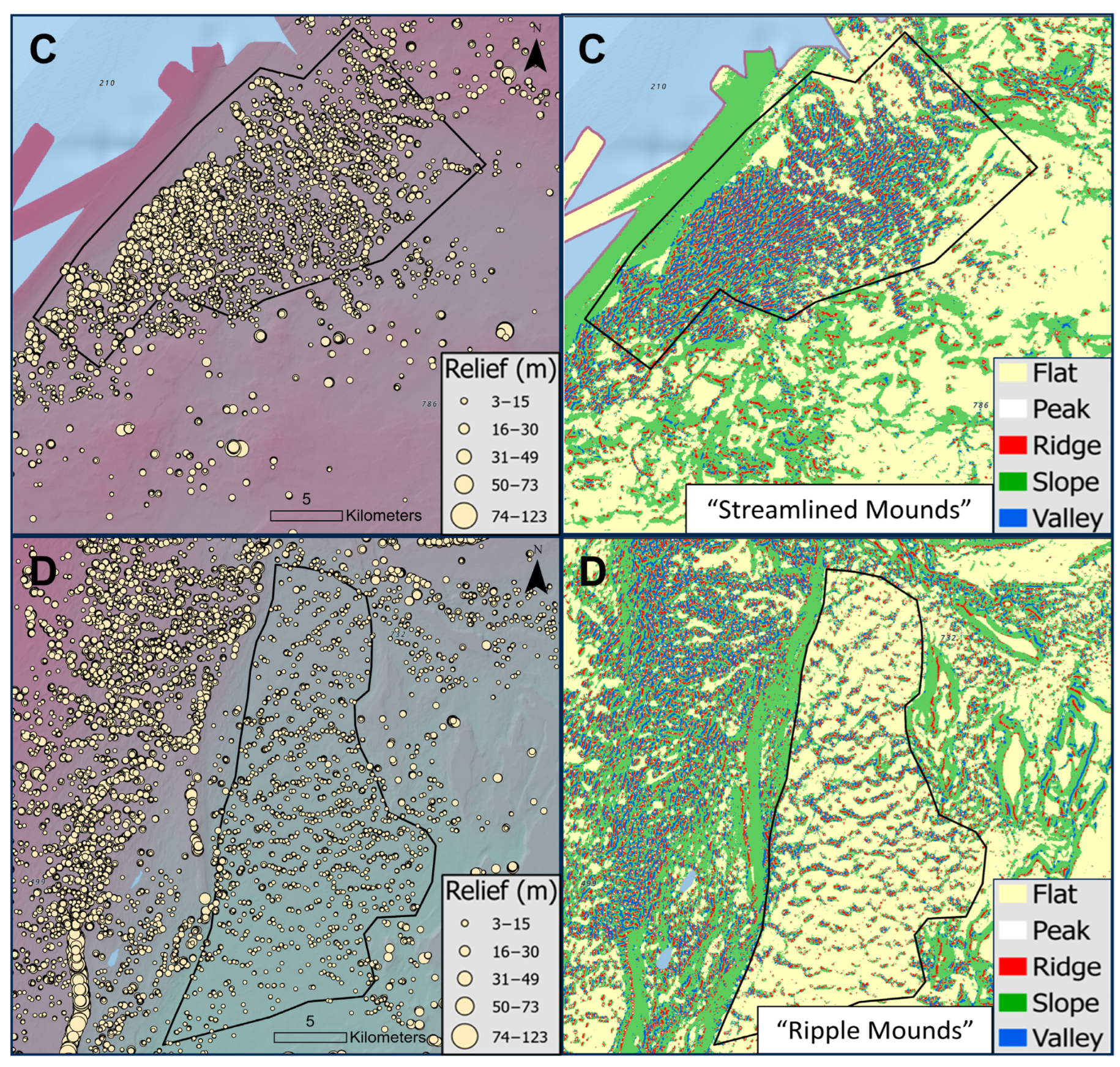
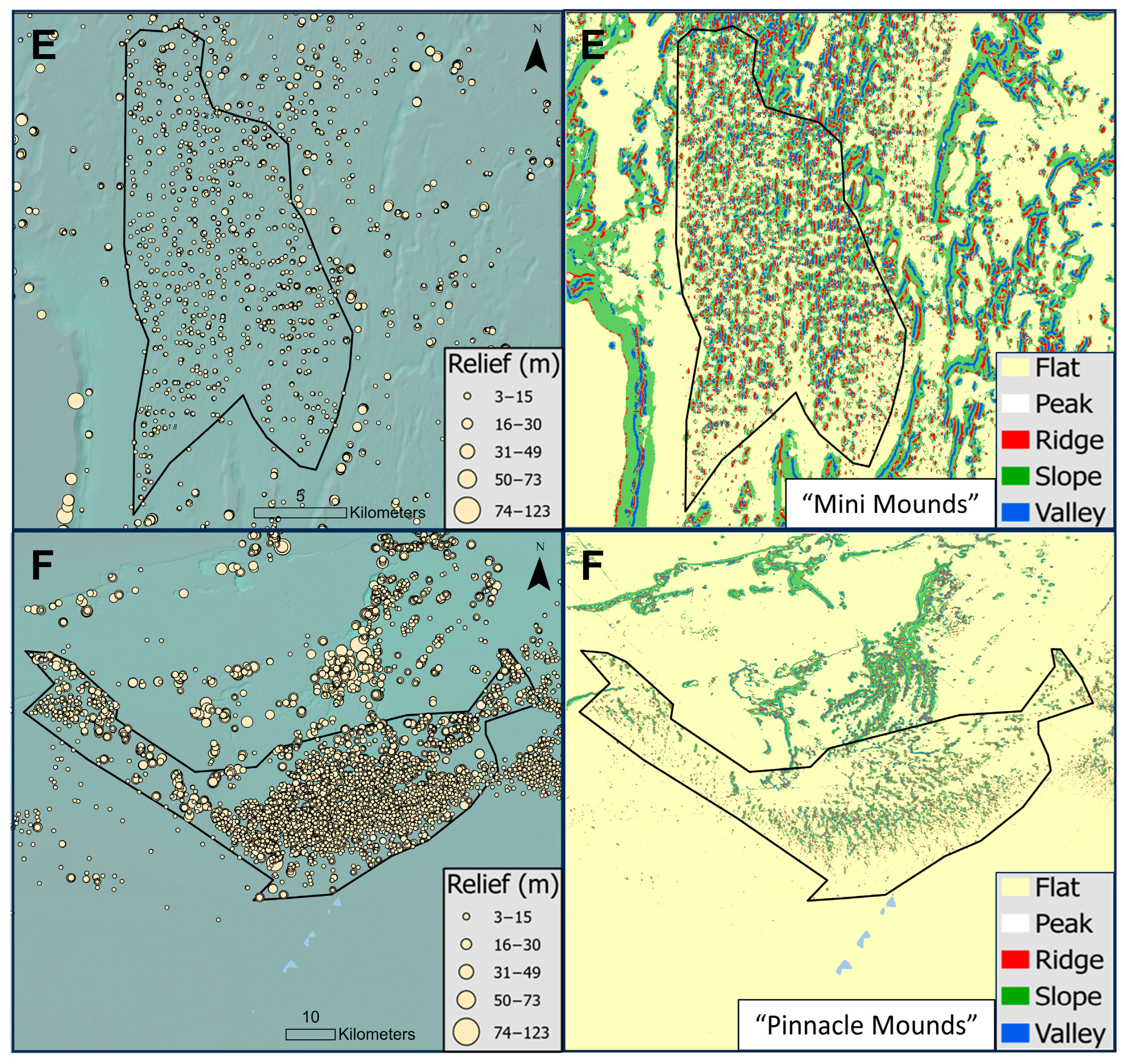


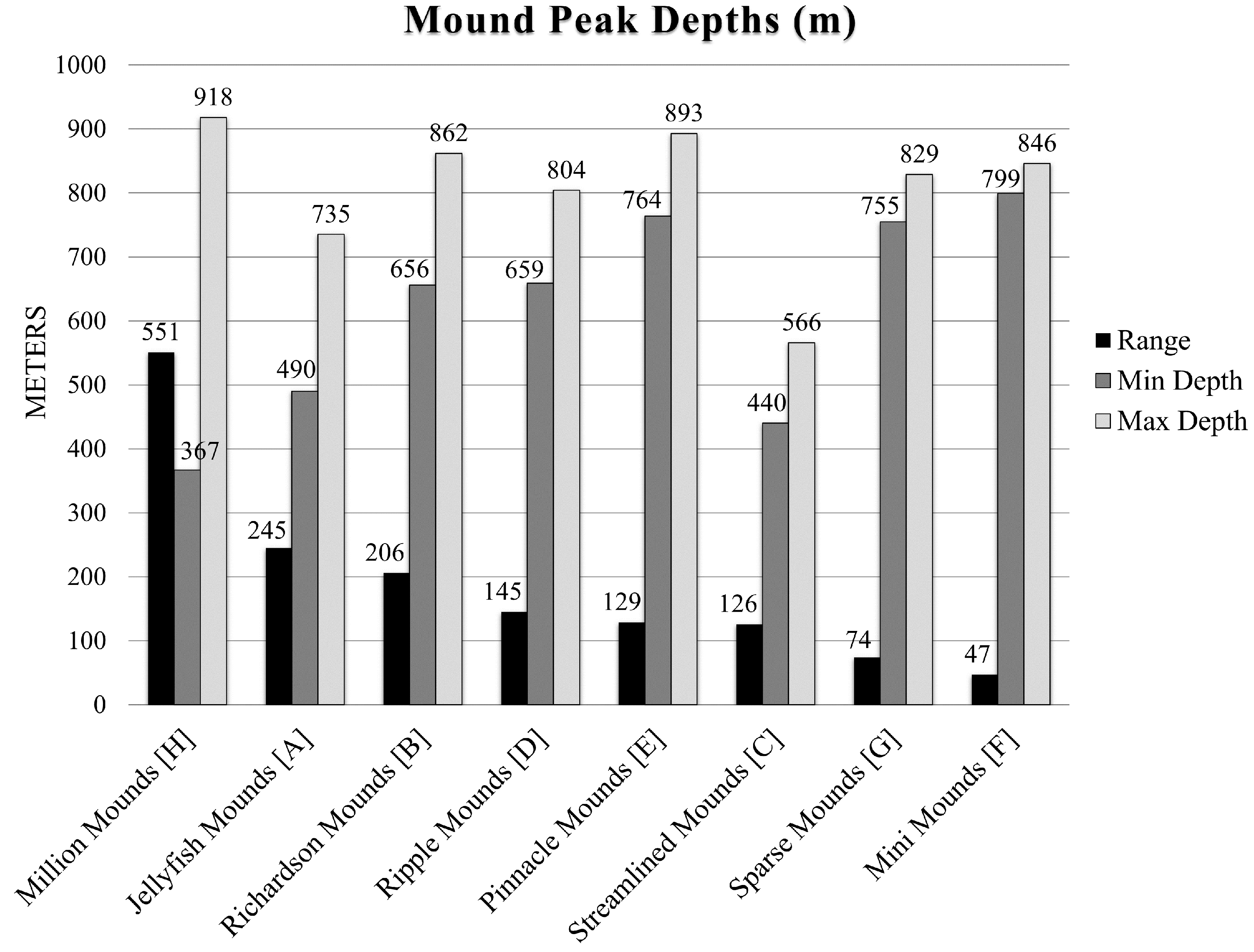

| DEEP SEARCH Class | Relationship to CMECS | CMECS Class/Subclass | Relationship Notes |
|---|---|---|---|
| Live ScleractinianCoral | Nearly Equal (≈) | Coldwater Stony Coral Reef | Live vs. dead coral cannot be described with CMECS substrate classes; the Biotic Component Group unit for live coral was used. |
| Dead Standing Coral-framework | Less Than (<) | Coral Reef Substrate | CMECS unit is not as specific. |
| Coral Rubble | Equal (=) | Coral Rubble | |
| Sediment | Greater than (>) | Fine Unconsolidated | Sediment in the DEEP SEARCH schema includes gravel classes. Anything smaller than cobble may be included, but gravel classes were rare in dive areas. |
| Sedimented Bedrock | Nearly Equal (≈) | Bedrock/Co-occurring element modifier Fine Unconsolidated | This class was used when the dominant substrate was clearly bedrock, but >50% had sediments thick enough to preclude most sessile reef-associated fauna. |
| Exposed Bedrock | Less Than (<) | Bedrock | |
| Cobble | Nearly Equal (≈) | Cobble | Exact size thresholds unclear. |
| BRESS Landform Units from Study | CMECS Geoform Units Applicable to Study Area | Potential New CMECS Provisional Geoform Units |
|---|---|---|
| Peak | Closest analog is “Knob” but it is of geologic origin, not biogenic. | Mound Peak (if CWC mound) Scarp Peak (if on scarp feature) |
| Ridge | Ridge (no change) | Mound Ridge (if CWC mound) |
| Valley | Valley (current definition needs expansion beyond continental shelf) | Mound Valley (if adjacent to CWC mound) Scarp Valley (if at base of scarp feature) |
| Slope | Slope (no change) | Mound Slope (if CWC mound) |
| Flat | Flat (no change) | -- |
| Scarp/Wall Fault Scarp Erosion Scarp | -- | |
Deep/Cold-water Coral Reef
| New Level 2 units under CWC Reef
|
| Mound Subregion Name | # of Peaks | Peak Density (#/km2) | Area of Peaks (km2) | Mound Relief Metrics | Mound Peak Min Depth (m) | Mound Peak Max Depth (m) | ||||
|---|---|---|---|---|---|---|---|---|---|---|
| Min (m) | Max (m) | Mean (m) | Median (m) | Std. Dev. (m) | ||||||
| A. Jellyfish | 1043 | 3.1 | 7.1 | 3 | 171 | 32 | 27 | 20.8 | 490 | 735 |
| B. Richardson | 1342 | 2.8 | 7.7 | 3 | 161 | 45 | 36 | 32.5 | 656 | 862 |
| C. Streamlined | 1626 | 4.8 | 8.1 | 3 | 76 | 19 | 18 | 8.7 | 440 | 566 |
| D. Ripple | 833 | 2.6 | 3.7 | 3 | 28 | 10 | 10 | 3.5 | 659 | 804 |
| E. Mini | 554 | 2.7 | 1.8 | 4 | 23 | 9 | 9 | 3.1 | 799 | 846 |
| F. Pinnacle | 2443 | 1.2 | 13.8 | 2 | 55 | 18 | 16 | 9.5 | 764 | 893 |
| G. Sparse | 228 | 0.2 | 1.8 | 4 | 56 | 35 | 36 | 8.5 | 755 | 829 |
| H. Million | 35,789 | 5.8 | 186.3 | 3 | 107 | 19 | 17 | 10.2 | 367 | 918 |
| Entire Region | 83,908 | 0.8 | 411 | 0 | 226 | 20 | 16 | 13.4 | 168 | 2707 |
Disclaimer/Publisher’s Note: The statements, opinions and data contained in all publications are solely those of the individual author(s) and contributor(s) and not of MDPI and/or the editor(s). MDPI and/or the editor(s) disclaim responsibility for any injury to people or property resulting from any ideas, methods, instructions or products referred to in the content. |
© 2024 by the authors. Licensee MDPI, Basel, Switzerland. This article is an open access article distributed under the terms and conditions of the Creative Commons Attribution (CC BY) license (https://creativecommons.org/licenses/by/4.0/).
Share and Cite
Sowers, D.C.; Mayer, L.A.; Masetti, G.; Cordes, E.; Gasbarro, R.; Lobecker, E.; Cantwell, K.; Candio, S.; Hoy, S.; Malik, M.; et al. Mapping and Geomorphic Characterization of the Vast Cold-Water Coral Mounds of the Blake Plateau. Geomatics 2024, 4, 17-47. https://doi.org/10.3390/geomatics4010002
Sowers DC, Mayer LA, Masetti G, Cordes E, Gasbarro R, Lobecker E, Cantwell K, Candio S, Hoy S, Malik M, et al. Mapping and Geomorphic Characterization of the Vast Cold-Water Coral Mounds of the Blake Plateau. Geomatics. 2024; 4(1):17-47. https://doi.org/10.3390/geomatics4010002
Chicago/Turabian StyleSowers, Derek C., Larry A. Mayer, Giuseppe Masetti, Erik Cordes, Ryan Gasbarro, Elizabeth Lobecker, Kasey Cantwell, Samuel Candio, Shannon Hoy, Mashkoor Malik, and et al. 2024. "Mapping and Geomorphic Characterization of the Vast Cold-Water Coral Mounds of the Blake Plateau" Geomatics 4, no. 1: 17-47. https://doi.org/10.3390/geomatics4010002
APA StyleSowers, D. C., Mayer, L. A., Masetti, G., Cordes, E., Gasbarro, R., Lobecker, E., Cantwell, K., Candio, S., Hoy, S., Malik, M., White, M., & Dornback, M. (2024). Mapping and Geomorphic Characterization of the Vast Cold-Water Coral Mounds of the Blake Plateau. Geomatics, 4(1), 17-47. https://doi.org/10.3390/geomatics4010002








